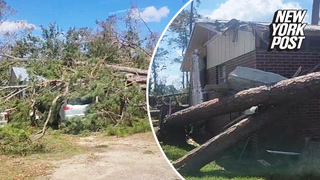In recent days, a powerful storm named Helene swept through communities in Georgia, leaving a path of destruction in its wake. The storm’s fury was particularly evident as it toppled trees, damaged homes, and disrupted daily life for many residents. This event serves as a stark reminder of the increasing severity of weather patterns due to climate change and the importance of preparedness in the face of natural disasters.
As the storm approached, meteorologists warned of its potential impact, citing not only high winds but also heavy rainfall that could lead to flooding in vulnerable areas. According to the National Weather Service, storms of Helene’s magnitude have become more common in recent years, a trend that aligns with findings from various climate studies. For instance, a report from the Intergovernmental Panel on Climate Change highlights that warming ocean temperatures contribute to the intensity and frequency of storms, impacting communities worldwide.
In the aftermath of Helene, residents faced the daunting task of assessing the damage. Many were left without power, and emergency services worked tirelessly to clear the roads and restore order. The sight of uprooted trees scattered across neighborhoods painted a vivid picture of nature’s might, but it also raised significant questions regarding local infrastructure and emergency readiness. How equipped are communities to handle such disasters? Are there sufficient resources in place to aid recovery efforts?
Experts emphasize the need for communities to develop comprehensive emergency plans that go beyond immediate response. “Preparedness is not just about having supplies on hand,” says Dr. Emily Carter, a disaster management specialist. “It involves educating the public about risks, encouraging family emergency plans, and improving infrastructure to withstand severe weather events.”
Moreover, the psychological impact of such storms should not be underestimated. Residents often face feelings of anxiety and uncertainty long after the winds have died down. Mental health professionals urge communities to provide support systems that address these emotional challenges. This includes counseling services and community gatherings to foster resilience and social cohesion.
As communities begin to rebuild, there is an opportunity to reassess and strengthen their approach to disaster preparedness. Initiatives such as tree maintenance programs can help mitigate the risk of falling trees during storms, while investment in green infrastructure can enhance urban resilience against flooding. Furthermore, local governments might consider implementing stricter building codes to ensure that structures can better withstand extreme weather conditions.
In conclusion, while the immediate impact of Helene has been felt acutely, it also opens the door for critical discussions about climate resilience, community preparedness, and mental health. As we move forward, it is essential to learn from these events, ensuring that we not only recover from the storm but also build a stronger foundation for the future. By fostering a culture of preparedness and support, communities can better weather the storms yet to come.

